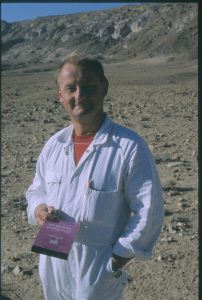
Looking down the narrow Wadi Hafir valley, one of the key rock art and inscription sites surveyed by the AMAES. Photo by Michael Bannigan.
About the AMAES
The ‘Aqaba-Ma‘an Archaeological and Epigraphic Survey (AMAES), directed by the late William (Bill) Jobling of the University of Sydney from 1980–1990, was the first official comprehensive survey of the ancient remains found in the Hisma/Wadi Ramm desert of southern Jordan. While the Hisma’s most prominent archaeological and epigraphic sites had been documented by earlier scholars, most notably George Horsfield, R. Savignac, G. Lankester Harding, and Diana Kirkbride, the AMAES aimed to fully explore the entirety of the region’s vast network of sweeping valleys, towering rock faces, and sprawling boulder fields. In all, the survey explored an area of more than 2,500 sq km, extending from the Red Sea port city of ‘Aqaba in the west to the desert outpost of Mudawwara in the east, and from the well-watered Ma‘an plateau and Ras an-Naqab escarpment in the north to Jordan’s desert border with Saudi Arabia in the south.

During the course of its nine official field seasons, the AMAES explored a broad range of sites, features, and artifacts that provided abundant evidence of ancient human activity in the Hisma. In addition to discovering remarkable settlement and habitation sites, including the rock shelters at Hedeib al-Fala and Tell al-Kharaza and an early Islamic village and open-air mosque in Wadi Shireh, the survey documented the remains from several extensive wadi systems that were intensively used and settled in the past, including Wadi Um Sahm, Wadi Rabigh, and Wadi Hafir. Amid these wadi systems, the survey discovered numerous springs, catchment pools, wells, cisterns, and dams, but also thousands of boulders and rock faces carved with inscriptions and rock drawings of various date. From the third season on, the recording and documentation of these epigraphic and rock art remains became the survey’s primary focus.
Of the thousands of recorded inscriptions, the vast majority were written in Thamudic E/Hismaic (the local Ancient North Arabian script/dialect), although far smaller numbers of South Arabian, Nabataean, Greek, and early Arabic/Kufic texts were also found. In addition, the survey photographed countless rock drawings dating from prehistoric times to the present, but with a particular emphasis on the well-carved and signed drawings that often accompany the Thamudic inscriptions.

Although the entire collection of epigraphic material recorded by the AMAES still awaits final publication, Jobling did provide many initial readings, translations, and commentaries in his numerous preliminary reports and, in doing so, helped confirm the correct reading of several important graphemes within the Thamudic E script as well as the shared linguistic, cultural, and religious context of the Hisma tribes and the Nabataeans of Petra.
The AMAES Team

Throughout the survey, Dr. Jobling was assisted by Richard Morgan, then a recent graduate in archaeology and geography from the University of Sydney who joined the project for several key seasons as cartographer and field photographer. In the survey’s later years, longtime University of Sydney administrator Michael Bannigan served as Jobling’s field assistant and was also responsible for photography. The AMAES was conducted with the permission and sanction of the Department of Antiquities of Jordan and was assisted by several representatives from the department, including Sami Rabidi, Nabil Bqa’in, Zeidoun al Muheisen, and Suleiman Farajat. At various times, other scholars, experts, and surveyors participated in the project, including Crystal Bennett, then director of the British Institute in Amman, Godfrey Tanner, professor of Classics at the University of Newcastle, and Lee Jobling, Bill’s wife. Archaeologists Eugene Stockton, Daniel Tangri, and Ina Kehrberg also assisted in analyzing and drawing many of the survey’s lithic finds. Outside the field, Elizabeth Roberts, then resident in Jerash, provided valuable logistical and on-the-ground support to the project during and between field seasons, while Lucy Davey served as Jobling’s chief research assistant at the University of Sydney.
